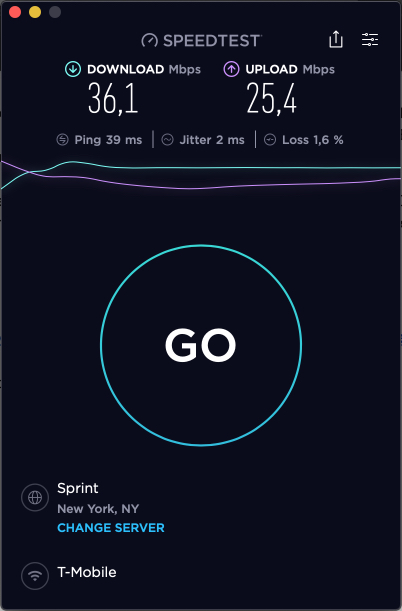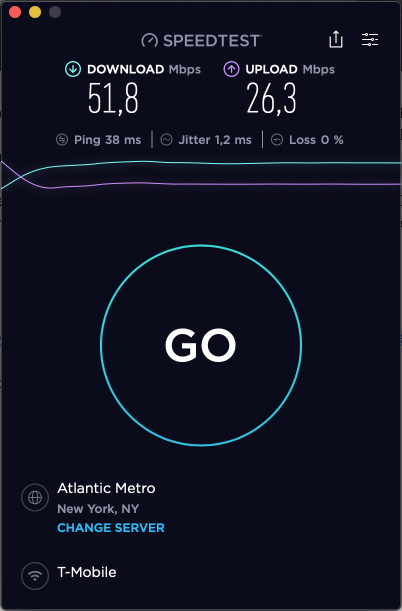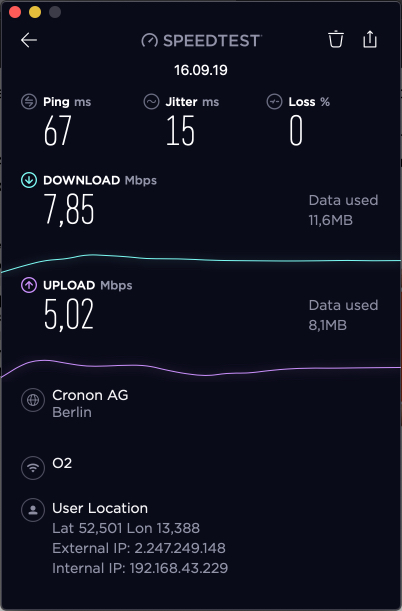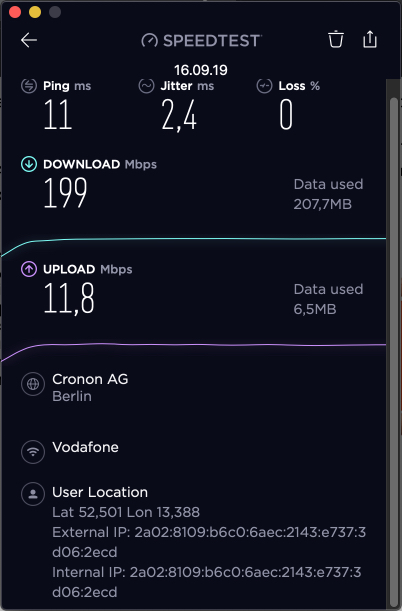I travel a lot. Between crappy hotel Wi-Fi, the Great Firewall of China, and other impediments, getting a reliable internet connection away from home isn't always easy. That's where portable hotspots, or MyFis as they are sometimes known, come in.
I've tried a few MyFis in the past and did not have a great deal of luck. Some required endless troubleshooting, others failed to deliver enough battery life to be relied upon, and the rest were simply too unreliable and finicky to consider a real solution. So while I was excited to check out the Skyroam Solis X, I can't say I was particularly hopeful.
Best Wi-Fi hotspots you can buy | Apps for boosting your internet signal
What is the Solis X?
The Solis X is a small, hockey puck-shaped MyFi with a grand total of one button, so it's dead easy to use. It has a 4,700mAh battery and charges through a USB-C port that you can also use to reverse-charge your phone.
There's an 8MP camera because … I'm not entirely sure, and a built-in Solis X smart assistant powered by IFTTT. You can also use the Solis X assistant to buy an unlimited internet daypass, subscribe for a whole month, or pay as you go per gigabyte.

How easy is it to use?
Setting up the Solis X is deceptively simple. I've dealt with several MyFis over the years and this was definitely on the idiot-proof end of the usability spectrum. Press the single button on the device and wait for the lights to stop flashing. You can connect to the Solis X's internet connection either via your phone or laptop's usual Wi-Fi menu or through the Solis Wi-Fi app for iOS or Android.
If you download the app you can also use the QR code on the bottom of the Solis X to pair and connect. The app is very straightforward and provides several additional features and controls. A short tutorial the first time you open it shows you how to activate the camera or voice assistant, and three buttons at the bottom of the app let you see your status, buy more data, or access your account info.
Setting up the Solis X is deceptively simple.
Just tap the big button in the middle to connect to the Solis X (assuming it is turned on). Once connected, a hamburger menu in the upper right provides access to more settings and options.
A hotspot with a camera?
The Solis X has a built-in 8MP camera, but I can't say I found the camera to be of much use. To see what it is capturing, and to fire the shutter, your phone needs to act as a viewfinder. Your phone probably has a better camera on it already.
There's also no way to use the camera on the Solis X if your phone battery dies, which undermines what might have otherwise been a cool backup camera if your phones dies and them aliens finally land. At least you can plug your dead phone into the Solis X to charge it if you have the right cable. The Solis X charges a phone at 5V/1A so it's not going to break any speed barriers. It comes with a USB-A to USB-C cable and a USB-A to USB-C adapter, though, so it can come in handy in a pinch.
The camera has 1x, 2x, and 3x zoom capabilities, and the images are pretty decent considering you're taking them with a hotspot. I'm still not entirely sure why you wouldn't just use your phone's camera though.

It's a smart MyFi too
The IFTTT-powered Solis X assistant lets you download applets that can be used to control your phone, send pics to social, check the weather, send an emergency SMS, and so on. I found the virtual assistant a little pointless. My phone and headphones have Google Assistant and my laptop has Siri, and I'm happy enough with them on 99% of tasks.
Knowing I have access to an internet-connected assistant even if I lose my phone and laptop is some comfort I guess, but I'm not entirely sure what good it'd do me, barring using the find my phone feature. It seems like an unnecessary add-on with not a huge amount of use-value. After all, you could just use IFTTT on your phone and be done with it.
Still, having a camera and smart assistant lets Skyroam, the Solis X's maker, declare it to be the world's first (and only) smart hotspot and, well, I guess marketing matters.
Access to an internet-connected assistant even if you lose your phone and laptop is some comfort I guess.
What's the Solis X hotspot like to use?
What matters to me is not how crispy the photos out of my hotspot are, but how reliable and stable the internet connection is. The make or break feature of any and all MyFis is how seamless and simple the experience is, and whether or not you consider them good enough to contribute to your precious luggage allowance. (On that note, the Solis X weighs 312 grams, so it's not terribly heavy or big.)
You can connect up to ten devices to the Solis X, although I tended to only have my phone and/or laptop connected at any one time. Skyroam says its battery will get you 16 hours of internet access and in my testing with one or two connected devices, that claim holds up. If you use it to reverse-charge your phone at all, expect a pretty big ding to that number.

What are the internet speeds like?
Not great, unfortunately. While I found the Solis X to be simple and reliable to use, I never got anywhere near what I'd call true LTE speeds out of it. I used the Solis X in Berlin, Manhattan, Brooklyn, and Lisbon. Despite the Solis X connecting to local 4G networks, I wasn't seeing real 4G speeds, presumably due to network congestion.
The worst speeds were in Berlin and Manhattan, where the Solis X was barely even usable despite connecting to major carriers 02 and T-Mobile, respectively. No matter where I went, the Solis X never exceeded 60Mbps down and 30Mbps up. 30Mbps upload speeds are actually pretty decent, but download speeds were generally bad everywhere.
In Berlin, I was averaging between 15-20Mbps down and up. Lisbon was similar. Manhattan was terrible, with speeds dropping to between 0.5-3.5Mbps down and 8-15Mbps up. Brooklyn fared best, with 35-55Mbps down and 25-28Mbps up. So unless you only need a portable hotspot for the occasional upload, the Solis X is hard to recommend for power users.
The Solis X is hard to recommend for power users.
What bands does it support?
Despite trying the Solis X in several cities in several countries, I never got hotspot speeds I would consider good. The Solis X itself works fine, but the quality of the internet service it provides is not.
I regularly resort to using my phone to upload videos when necessary and I always get better speeds than I saw with the Solis X. Depending on where you live, a data SIM with roaming enabled might serve you better.
The Solis X supports the following:
Networks: FDD-LTE; TDD-LTE; WCDMA
FDD-LTE: Band 1/2/3/4/5/7/8/12/17/18/20/25/26/28/71
TDD-LTE: Band 38/39/40/41
WCDMA: Band 1/2/4/5/8

- Brooklyn – Solis X test 1
- Brooklyn – Solis X test 2
- Brooklyn – Solis X test 3
- Berlin – Solis X data speeds
- Berlin – home Wi-Fi speeds
- Berlin – cabled internet speeds
Virtual SIM and carrier agreements
I reached out to Skyroam about the lackluster speeds when I first started using the Solis X in Berlin. Skyroam told me that "Germany has an outdated broadband service and the connection can sometimes be a little weaker, especially in rural areas. As Skyroam gets its connection through virtual SIM technology and relationships with 300+ carriers worldwide, it would make sense that the local carriers might not be as great, which results in slower speeds."
Skyroam gets its connection through virtual SIM technology and relationships with 300+ carriers worldwide.
That response wasn't particularly convincing because I live in the middle of Germany's capital. I also didn't see significantly better performance in either New York City or Lisbon. Either Skyroam's carrier partners don't provide it with fast 4G speeds or the Solis X just can't deliver high-speed internet in heavily populated areas. Considering how often people tend to travel to large cities, the Solis X's utility value becomes questionable.

Is the Solis X worth it?
$179.99 for the puck is a pretty steep price to pay, and I suspect it'll be a sufficiently steep barrier to entry for many. For those who travel a lot or frequently need Wi-Fi access on the go, it might be an acceptable investment, especially if your company foots the bill. But for what you get, it's hard to recommend the Solis X over just tracking down free Wi-Fi in a hotel or cafe.
Data pricing isn't exactly cheap either, so I wouldn't recommend this as an everyday solution for the average person wanting data on the go. For that, you'd probably be better off just tethering from your phone and buying a cheap power bank. Or just heading to a Starbucks.
If you're not the one paying for your Solis X or data, the global bands the Solis X supports are going to be its killer feature. Skyroam's virtual SIM (vSIM) connects to local networks in over 130 countries. It's the same thing Google does with its excellent Google Fi MVNO (formerly known as Project Fi). Just don't expect blazing-fast 4G speeds worldwide.

How much does data cost?
Data pricing on the Solis X is clear and straightforward. You can buy an unlimited day pass for $9/€8, secure a month's worth of unlimited access for $99/€80, or purchase a gigabyte of data for $9/€5 that lasts for 30 days or until you use it up.
No, it's not as cheap as some high-speed hotel Wi-Fi options, but you get to take it with you. You also don't have to worry about your phone supporting international bands. That's not nothing. Just don't expect 200Mbps download speeds.
Data pricing on the Solis X is clear and straightforward, but it isn't exactly cheap.
You definitely need to be aware of the Fair Use Policy and daily throttling limit, which applies to Unlimited Monthly Subscription and Global Daypass users. On the unlimited access plans Skyroam obviously wants to limit how much data you can consume. I asked Skyroam for clarification on when throttling kicks in and was told that "daily limits vary by time, location, and carrier network partners."
Throttling does not apply to GoData Monthly Subscription users (where you get 1GB for $9/€5). With pay-per-GB plans, the point seems to be to give you full-speed Wi-Fi so you blow through your limit quickly and then buy more. I'm not sure I like the approach here.

Who is the Solis X for?
Before buying into the Solis X experience, you should consider where you travel and what you plan to use it for. If you only plan to connect infrequently for emails and light web surfing, it's fine. If you plan to backpack for a couple months and want this to be a mobile equivalent of the Wi-Fi you use at home, think again.
The daily thresholds will slow you down very quickly if you're streaming movies. No matter which way you cut it, it's going to get expensive if the Solis X is your only source of internet. If you travel a lot in the EU, you might be better off buying a data SIM for your phone. That way you can use it for tethering now that roaming charges are a thing of the past.
Best unlimited data plans | Google Fi now has an unlimited plan
Google Fi is another decent alternative if you're open to switching carriers because Fi "network hops" for the best signal just like the Solis X. Google Fi includes a VPN and is already in your phone which can be used to tether other devices. Doing this means you'll need an external battery bank to avoid killing your phone, but it'll likely work out cheaper in the long run.
If you're willing to buy into the $99 truly unlimited GoData subscription, the Solis X could reasonably become your sole source of internet. But it will never be as fast as many other available sources of Wi-Fi.

Skyroam Solis X review: The verdict
Overall I have very mixed feelings about the Solis X. When its connection speeds were decent it was very reliable. I also liked how easy it was to set up and use, and I think the size and weight trade-off is perfectly acceptable.
Unfortunately, its data speeds were far too inconsistent and pricing too expensive for me to consider relying on it permanently. I also thought the camera and voice assistant were gimmicky additions with limited utility at best.
To make this a must-have, Skyroam needs to deliver faster connections more consistently. It also needs to get data pricing down to something akin to smartphone data plans.
More posts about Wi-Fi
from Android Authority https://ift.tt/35xHK7h
via IFTTT




















No comments:
Post a Comment